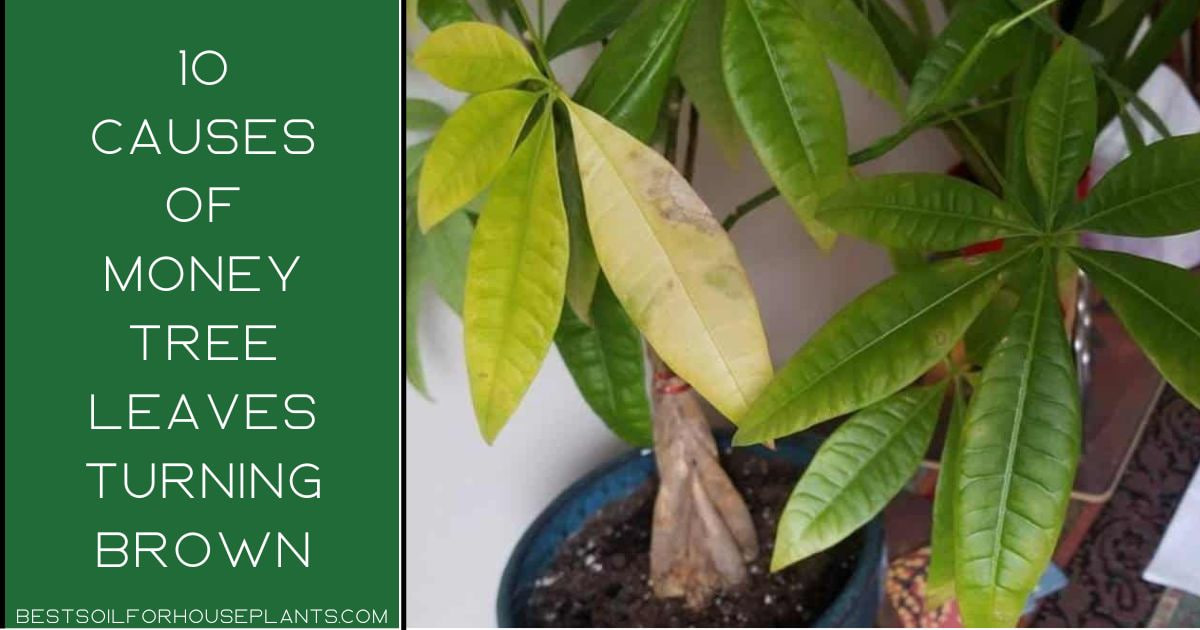Money Tree Leaves Turning Brown(Pachira Aquatica) may be a popular choice for many people as a houseplant, but it can be hard to take care of because it has a thirst for moist soil. Direct sunlight and intense heat can cause the delicate money tree leaves to turn brown due to temperature stress and poor watering.
Therefore, it is important to closely monitor the levels of indirect light, water your money tree only when the top 1-2 inches of soil are dry, and ensure proper drainage to avoid unwanted root rot. Taking proper steps to nurture your Money Tree is an essential part of making sure your Money Tree will have healthy and beautiful leaves.
What Causes Money Tree Leaves To Turn Brown? (Solutions & Preventive Measures)
Money Trees, or Pachira aquaticas, are a popular addition to many homes due to their tropical evergreen-deciduous characteristics and 10-15 year lifespans. To ensure your Money Tree stays at its best, make sure it has indirect sunlight as direct sunlight can cause its money tree leaves turning brown. Its money tree leaves tend to brown when the soil becomes too wet and in direct sunlight the water evaporates quicker leading to inadequate hydration growing unhealthy browning of the leaves.
Thus, by providing shade, with indirect light during the day, one will be able to save their Money Tree from harm while still allowing it to grow into a healthy plant.
Watching a young Money Tree with its usually-vibrant green hues start to turn brown can be an alarming sight for any plant lover. Unfortunately, this is something that occurs to most Money Trees as they age – yet when the prematurely fading leaves appear on a younger tree, it’s truly unnerving
[1] Have You Overwatered Your Money Tree?
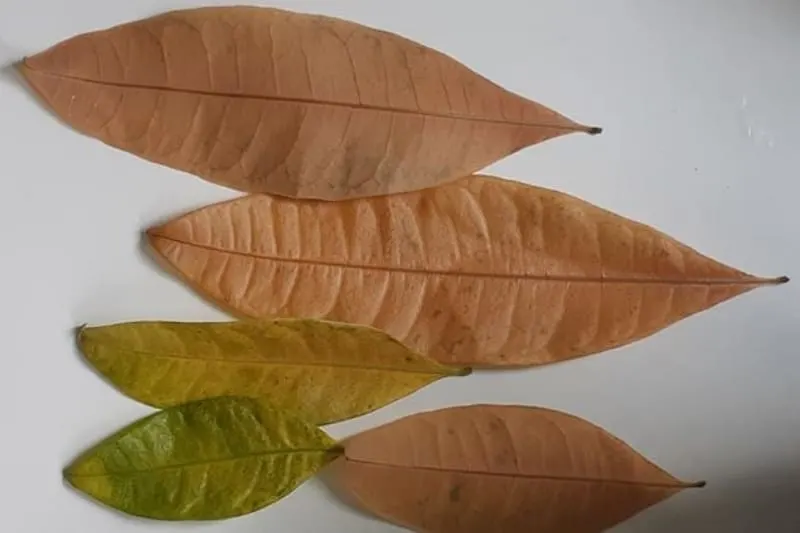
Money trees are not easy to overwater, but will benefit from regular watering. Although they do well with moisture in the growing medium, it is important to avoid waterlogging. Money tree leaves turning brown can be a sign of overwatering, as too much H2O displaces oxygen in the soil and stops the roots from getting the air they need to survive—leading to root rot and death of the plant. It is also important to shelter money tree leaves from direct sunlight, as this can cause scorch marks or unwanted discoloration.
A money tree is an easy-care houseplant, but you must be mindful to ensure that it doesn’t become overwatered. Even if the growing medium is moist, excess moisture in the soil can cause your money tree’s leaves to turn brown or yellow and potentially wilt. To prevent this from happening, keep the soil lightly damp—not soaking wet—at all times and make certain not to place the money tree in direct sunlight, as this will cause dryness and a general wilting of the overall plant itself. In conclusion, with proper monitoring and attention to their environment, any gardener should have success in keeping their beloved money trees green and healthy!
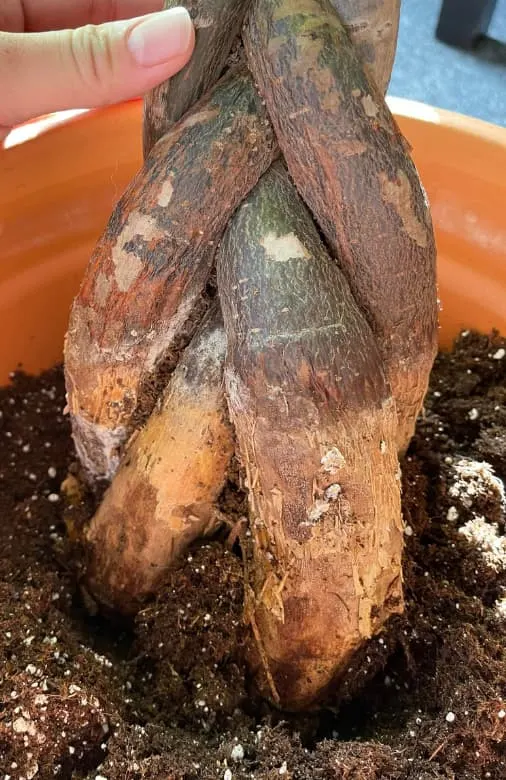
You may also notice the following signs of an overwatered money tree:
- The soil drains slowly after watering.
- Mold or mildew growth on the soil’s surface.
- indiscriminate leaf shedding
- A rotting odor emanates from the soil as a result of root rot.
- The stem is weak, swollen, or rotting.
You’d be forgiven for thinking that frequent watering is the only cause of overwatering. However, soil that is too wet or soggy for an extended period can cause it.
The following can cause or make money tree leaves turn brown from getting too much water:
- Irrigation frequency should not be reduced in colder weather or during the winter.
- Planting your plant in a medium that is poorly drained.
- After watering your plant, forget to empty the saucer, cachepot, or drip tray. Money trees dislike having “wet feet.”
- Water your plant frequently without waiting for the topsoil to dry out slightly.
- Use a container that is too large for your plant.
- Planting in a container with few or no drainage holes.
When your money tree is overwatered for an extended period, root rot is likely to occur. This can be concerning as it could mean your money tree leaves are turning brown, discolored, and wilting too. Luckily, this article provides a step-by-step recovery guide for an overwatered money tree. The first step is to remove the plant from its pot and inspect the roots – if you detect mushy dark brown or black roots, then root rot is likely at play.
The next step is to check each money tree leaf individually for signs of direct sun damage, as one overly coated leaf may start the chain reaction throughout the entire plant. With proper care and following our recommended recovery steps, your money tree will get back up on its feet in no time.
How to Fix an Overwatered Money Tree
If your money tree leaves are starting to turn brown, it may be a sign that the plant is beginning to wilt.
The first step to rescuing your sickly money tree is to make sure you aren’t over-watering it – soil should not remain moist for longer than a day or two between waterings. In order to promote faster drainage, make sure that the money tree is planted in well-draining soil and potted in a container with plenty of drainage holes.
To speed up the drying time further, consider relocating the money tree to an area where it can receive direct sunlight; this will help to contribute extra heat and rapid growth. If insufficient drainage is the issue, you may need to repot your money tree in a peat-based potting mix and add gravel, sand, or perlite.
Lastly, choose an appropriately sized container so that roots have enough space as they spread out. With some effort, your money tree should be back on its feet in no time!
[2] Dehydration Causes Brown Tips and Edges on Money Tree Leaves
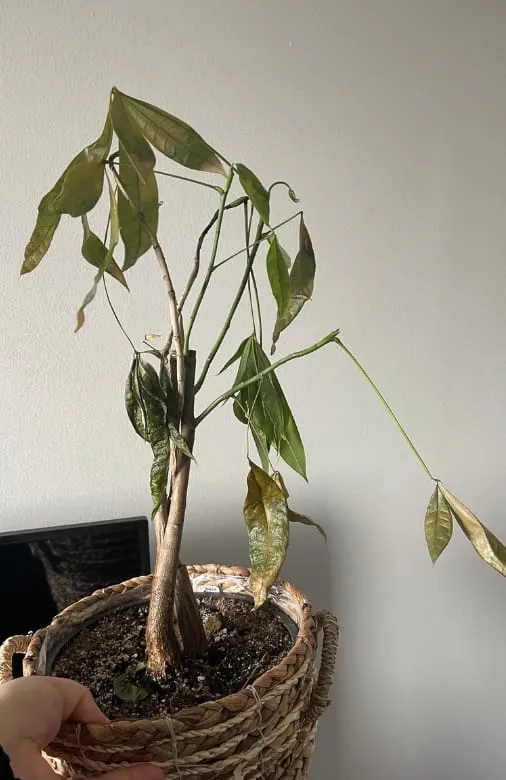
Have you noticed your money tree’s leaves turning brown with crispy edges? That’s usually a sign that the plant is not getting enough water and is dehydrated. To check for dehydration, take a look at your money tree’s oldest leaves. These tend to show signs of browning or crisping first. Additionally, you can make sure the soil isn’t dry and the pot doesn’t feel light in order to confirm dehydration. Be careful however, as too much water can also cause money trees to suffer from similar signs of distress. Too much direct sunlight – especially in hot climates – can also cause money tree leaves to turn brown.
Money trees are a distinctive and popular houseplant prized for their unique braided trunks. However, those same leaves that give it its distinct look can often be the first to suffer when faced with the consequences of underwatering. When a money tree is suffering from signs of underwatering like wilted brown or yellowed foliage, dry and crunchy leaves, shriveled or curled up leaves, and stunting, it’s best to act fast in order to revive the plant. If you’re lucky enough to catch your money tree in time, it may only take one sip for it to begin perking up again — but don’t forget that a money tree may need more water than other plants due to direct sunlight from windowsills or warm seasons.
How to Fix
When the soil is bone-dry, the leaves frequently turn brown. So give your money tree a good soaking if that’s the case. Here’s how to do it:
- Fill a basin or sink three to four inches deep with lukewarm water before beginning.
- Remove the outer pot (saucer) from your plant and let it soak in the bath for as long as you like.
- Wait 30-45 minutes or until the soil is sufficiently soaked.
- Empty the drip tray or cachepot after about ten minutes.
You should repot your plant if it’s rootbound or in an overly small pot.
[3] Sunburn

Money Trees love sunshine, but for the plants that stay indoors it is important to provide some shade. Otherwise, their leaves may become sunburned and look crisp from too much exposure – if you see this happening around the edges of your money tree’s leaves be sure to adjust its environment!
When your money tree leaves become sunburned, they no longer remain their bright green hue with crisp edges. Instead, the skin turns to a deep brown and may even appear burned in extreme cases. Thankfully, there’s an easy fix for this issue – simply adjust how much sunlight that hits the plant.
How to Fix
Is your green-thumbed baby beginning to suffer from sunburn? Checking the amount of sunlight it’s exposed to is essential. Try using a light meter throughout different times in order to ensure that you’re providing optimum growing conditions for your plants – whether indoors or outdoors.
Too much sun can be detrimental to your money tree, so if it’s been exposed to more than 6 hours of sunlight per day you should find a better spot that offers indirect light. Despondent leaves burned from the heat are beyond salvation; sadly they cannot regain their original color.
[4] Diseases

Money trees are disease-prone. Watch out for these diseases, especially if your plant is too moist:
- Anthracnose Leaf Spot: This fungal disease often appears on mature leaves as dark brown to tan spots. Although they usually only affect the lower or inner leaves, these fungi can quickly spread throughout the plant.
- Root Rot: Overwatering, fertilizer burn, or other causes of root damage can result in this opportunistic fungal disease. Affected roots are usually mushy, spongy, and brown or black in appearance. The rootball will have a somewhat pungent odor.
- Powdery Mildew: White spots on brown leaves indicate powdery mildew infestations. Leaf drooping, curling, and wilting are other signs to watch for.
These fungal infections cause rapid wilting and browning of the leaves. If left untreated, your money tree will die.
How to Treat Money Tree Diseases
- Anthracnose leaf spot disease can be prevented by adhering to good sanitation practices. Remove and dispose of diseased parts, such as leaves, twigs, etc. Pruning dead and decaying plants regularly can also help.
- Fungal root rot is a much more severe problem. You’ll need to remove the diseased roots and repot your money tree in new soil. A fungicide treatment may also be helpful.
- Use a fungicide that contains propiconazole to treat your money tree for powdery mildew. Additionally, increase circulation and lighting in the room.
[5] Pest Infestation
Pests like whiteflies, fungus gnats, spider mites, mealybugs, aphids, and scale insects can attack money trees.
Bugs that are sap-suckers can cause yellowish-brown spots on the foliage of your money tree because they’ve drained it of its vital juice and life.
Eventually, the entire tree’s leaves will turn yellow and brown, resulting in catastrophic damage to your money tree.
Solution for Money Tree Bugs
Keep your money blooming and healthy by taking proactive steps to protect it from pests. Inspect regularly for any signs of insects, then isolate the affected area promptly before treating with natural pruning techniques or other solutions. By staying vigilant against unwanted intruders in your financial garden, you can ensure that future harvests are as abundant and successful as ever.
- Manual removal: Using a washcloth or cotton swabs dipped in isopropyl alcohol, wipe down the stems, leaves, and other plant parts. It is most effective against mealybugs.
- Hose/wash them off: Wash the leaves of your money tree with a strong stream of water. Most bugs, including mealybugs, aphids, gnats, and whiteflies, should be deterred by this method.
- Insecticidal sprays: There are many ready-to-use insecticidal sprays you can use. I highly recommend organic soap or oil sprays containing neem oil, pyrethrin, rosemary oil, vinegar, mild dish soap, etc.
- Insect traps: I usually use yellow sticky traps to eliminate whiteflies. However, they are also effective against fungus gnats and their adult flies.
- Natural predators: Natural predators can also be used to get rid of money tree bugs, though this isn’t the most effective method. I use generalists like ladybug larvae and green lacewings when I need to get rid of soft-bodied bugs like spider mites, mealybugs, aphids, and scale insects.
[6] Old Leaves
Even the most vibrant money tree will experience some leaf turnover, as time and age take their toll. The oldest leaves usually reside at the bottom of the stem – but if you notice newer foliage turning brown before its time, something else may be amiss!
What To Do?
As the life force of a plant dwindles, its leaves become yellow and then eventually brown as they detach from their home. To keep your plants looking healthy and vibrant, prune off any unsightly ones that are partially-browned or yellowing to give them a fresh start.
[7] Fertilizer Burn
Money tree plants can bring a burst of color to any home, but they require proper care. Despite being low-maintenance and not heavy feeders, extra fertilizer still has the potential to damage them – transforming their lush green leaves into dry and brown ones with tips that curl up. Taking the right amount of caution will help keep your money tree looking its best.
Solution
To avoid over-fertilization, a good irrigation of the soil can help wash away salt residues and restore balance to nutrient levels.
[8] Nutrient Deficiency
Money trees may not be ravenous, but they can still suffer from unhealthy diets. Without the necessary nutrients to sustain their growth, leaves turn weak and yellow before ultimately progressing into a dull brown hue. Even with great care taken in feeding them properly, money tree owners should always keep an eye on its foliage’s health.
Solution
Nourish your money tree with a generous splash of fertilizer–but don’t forget to dilute it first! A small, diluted amount will work wonders and help the roots blossom.
[9] Temperature Stress and Frost Damage
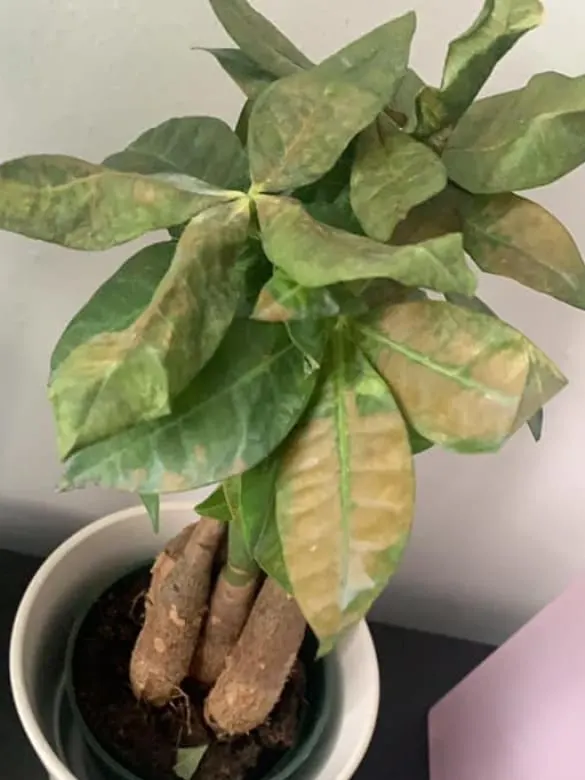
Money trees are beloved for their ability to thrive in hot and humid climates, from the tropical regions of Central America all the way down to USDA Hardiness Zone 9b. These luminary plants should be protected during cold weather – below 30°F (-1°C) temperatures can cause them serious harm.
A sudden shift in temperature, frosty temperatures or cold drafts can quickly cause your money tree’s luscious green leaves to fade and brown. If you are one for taking your houseplants out during balmy weather then be sure to watch out for signs of leaf damage.
Solution
- Relocate your money tree to a location where the temperature stays between 65 and 75 degrees Fahrenheit (18 and 24 degrees Celsius).
- Keep your money away from drafts, both cold and hot.
- Don’t expose your money tree to extreme temperature swings.
- Move your money away from fireplaces, heaters, air ducts, and other draft sources.
[10] Transplant Shock
If you just switched up the scenery for your money tree, don’t worry if some of its leaves turn brown. It’s often a perfectly natural reaction to new surroundings.
Repotting can seem like a daunting task, especially when it comes to your money tree. The difficult root system and necessary pruning of leaves make the process extra stressful – but with proper care you’ll be able to provide an ideal environment for your special plant.
What to Do?
Once your money tree has been relocated to a well-suited pot and soil, the process of reviving it can begin. From then on, make sure that you pay due attention to its needs – let in some airy breezes, maintain an adequate level of humidity and provide the right amount of light – so it may flourish.
How to Revive a Money Tree with Leaves Turning Brown
- The first step is to remove any severely damaged brown leaves. Use a clean, sharp pair of pruning snips.
- Remove any dead or fallen plant debris from the soil’s surface.
- Maintain a light moisture level in the soil at all times. Check the soil moisture every 2-5 days, and water again once the top 1-2 inches of soil have dried.
- Make sure that your money tree is growing in a well-draining potting mix.
- Adopt good gardening and sanitation practices, such as not touching wet plants with dirty hands and sterilizing garden tools.
- Avoid direct sunlight, drafts, and frost on your money tree.
- Allow for adequate air circulation and humidity levels.
Should I Cut Off Brown Money Tree Leaves?
Brown leaves are like a blanket on the Money Tree, blocking it from soaking up energy that can be used to foster new growth and flowering in future seasons. However, these same brown leaves could create an ideal environment for harmful pathogens – something we should definitely try avoiding.
Infected leaves will do more harm than good, as infection may spread to other parts.
- Begin the pruning process by snipping the whole leaf back to where it connects with the main stem.
- Additionally, prune some leggy growths along the way to shape the plant. Place the plant in filtered sunlight, with the cut areas facing the light source.
- After you are done, dispose-off the brown leaves by burning them to reduce the disease extent.
You can go through the video below to get details on removing the brown leaves from the Money Trees.
Should You Remove Brown Leaves from Money Trees?
Money Trees are hardy plants that will stay healthy and beautiful with the occasional pruning. Keep your tree in tip-top shape by gently removing any brown leaves all year long – it’s an easy way to prevent disease from spreading.
How Do You Fix Brown Leaves on Money Trees?
If your Money Tree is looking a bit worse for wear, it might be time to give it some special TLC. Try moving the plant near an east-facing window or another spot that gets indirect but bright light — this could do wonders for its health.
Why are my Money Tree Leaves Getting Brown Edges?
A Money Tree’s lush green leaves may show signs of distress if exposed to extended periods of dry air or scorching rays from the sun. Left unattended, those typically vibrant foliage can suffer serious damage in the form brown edges and reduced vibrancy.
What does overwatering a money tree look like?
Nature is always giving us signs when something isn’t quite right – too much rain or not enough, for example. If you notice a yellow leaf here and there in your garden, it could be an indication that the soil has become saturated with water due to excessive rainfall. Conversely, if brown spots start appearing on leaves then this can point towards dehydration; but look out for discolouration around the edges of leaves which may indicate over-irrigation.
Overwatered money tree look like?
A money tree that is overwatered looks like a lush, verdant paradise – but appearances can be deceiving. Too much water drowns its delicate roots, draining away any chance for it to reach its full potential and flourish into the bountiful symbol of prosperity we all wish to have in our lives.
How can you tell if a money tree is dying?
If your money tree appears to be fading, there are a few tell-tale signs that can reveal its suffering. Drooping leaves, wilting branches and discolouration of the trunk may all hint at an ill fate for your once vibrant plant companion.
Read more: Spider eggs in plant soil

